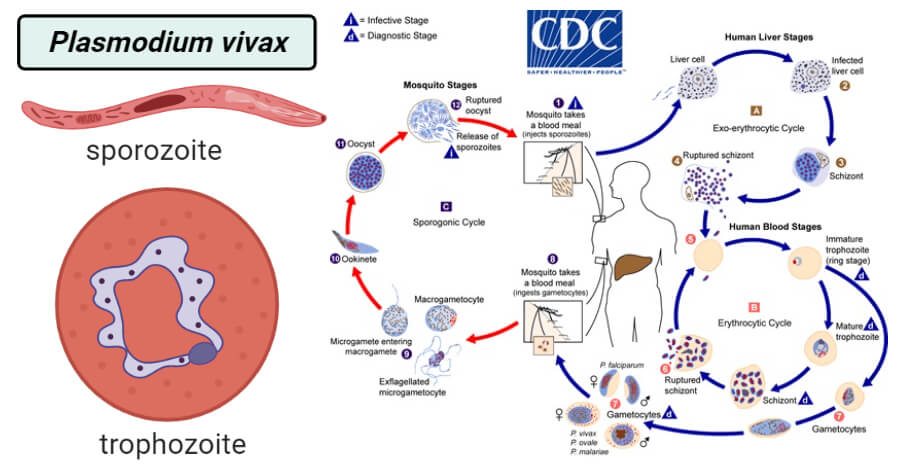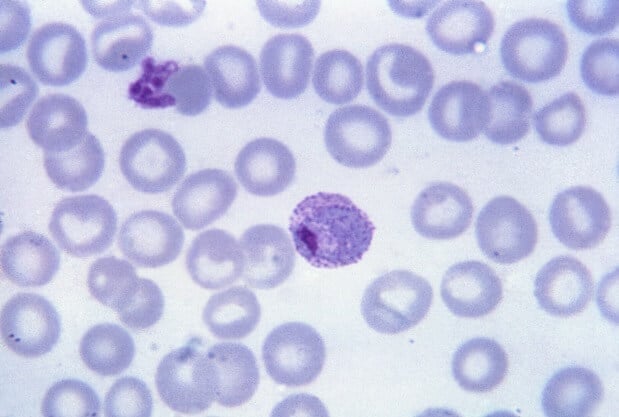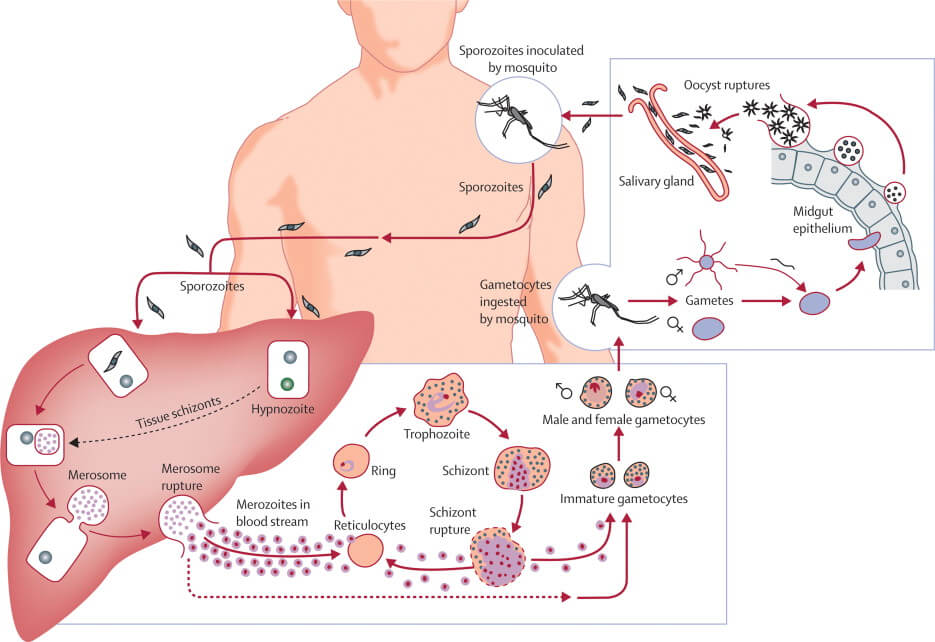Plasmodium vivax is a widely distributed protozoal parasite and a human pathogen that is responsible for human malaria. P vivax is not virulent as compared to Plasmodium falciparum. Plasmodium vivax can cause severe disease and death due to the enlargement of the spleen. They are transmitted through the female Anopheles mosquito.
Interesting Science Videos
Classification of Plasmodium vivax
| Domain: | Eukaryota |
| (unranked): | Diaphoretickes |
| Clade: | TSAR |
| Clade: | SAR |
| Infrakingdom: | Alveolata |
| Phylum: | Apicomplexa |
| Class: | Aconoidasida |
| Order: | Haemospororida |
| Family: | Plasmodiidae |
| Genus: | Plasmodium |
| Species: | P. vivax |

Image Source: CDC, created with biorender.com.
Host of Plasmodium vivax
- Plasmodium vivax needs two hosts to complete their life cycles, such as the human body and female Anopheles mosquito.
- The human body is the primary host while the female Anopheles mosquito is the secondary or intermediate host.
- There are several species that help in the transmission of malaria diseases such as maculatus, stephensi, fluvialitis, and culicifacies.
Habitat of Plasmodium vivax
- The hotspots of Plasmodium Vivax are Asia, Latin America, and some parts of Africa.
- A recent study showed that they mainly originated from wild chimpanzees and gorillas throughout central Africa.
- This protozoal parasite is responsible for 65% of malaria cases in Asia and South America.
- At lower temperatures, Plasmodium vivax can undergo sporogonic development like Plasmodium falciparum.
- There are about 71 mosquito species of Plasmodium vivax.
Plasmodium vivax Genome
- They contain about 12-14 linear chromosomes within 12-14 linear chromosomes.
- The estimated genome size is between 35 – 40 Mb.
- The GC-rich isochores are attributed to the Protein-coding genes, while the AT-rich isochores at the telomeres are attributed to chromosome ends.
- It is estimated that there are Approximately 5000 genes.
Plasmodium vivax Characteristics
- They performed anaerobic respiration.
- They follow both sexual and asexual reproduction.
- Their mode of nutrition is saprozoic, which occurs by osmotrophy.
- The locomotion organs such as contractile vacuole, etc., are absent.
- They required to host for the life cycle.
Plasmodium vivax Structure
The ultrastructure of Plasmodium vivax has been observed by using an electron microscope.

Figure: Giemsa-stained, thin-film blood smear photomicrograph reveals the presence of a mature, Plasmodium vivax trophozoite, which was stippled with numerous Schüffner’s dots. Image Source: CDC.
- Inside the red blood cell, Plasmodium vivax contains a double membrane, and the plasmalemma closely applied to the cytoplasm.
- The cytoplasm contains ribonucleoproteins containing small dense particles.
- The endoplasmic reticulum of Plasmodium Vivax resembles vesicles of variable shapes and not well developed.
- These are either smooth surfaced or rough-surfaced and remain scattered in the cytoplasm.
- The double membrane containing mitochondria has peripheral cristae and a structureless central region.
- The number of mitochondria in Plasmodium vivax changes with the age. For example, merozoite contains one mitochondrion whereas the trophozoite contains several mitochondria.
- The Golgi apparatus are made of several small vesicles that are arranged in rows.
- The plasmalemma is attached with a double-layered concentric body. It looks like the concentric body is originated from the plasmalemma.
- In 1965, Rudzinska assumed that the concentric bodies serve all the essential functions of mitochondria.
- The cytoplasm also contains 1 – 2 double-membrane vacuoles with a structureless matrix. The functions of these double-membrane vacuoles are not known.
- It has a larger nucleus and the nucleoplasm is made up of granular and fine fibrillar material.
- The nucleus contains a double membrane where RNA particles are attached.
- The nucleus contains nucleolus which lies centrally.
- The cytoplasm contains Pinocytosis vacuoles which function as food vacuoles.
- Sometimes the food vacuoles contain hemozoin which depends on the species of Plasmodium.
Life cycle of Plasmodium vivax
They complete their life cycle within two hosts as mentioned above. Both asexual and sexual methods are involved in the life cycle of Plasmodium vivax. The Asexual method is completed within the human body and the sexual method is completed within the female Anopheles mosquito through the gametogony, syngamy, and sporogony.

Image Source: https://doi.org/10.1016/S1473-3099(09)70177-X
(i) Life-Cycle of P. vivax in the Human body (Asexual Cycle)
The life cycle of P. vivax within the human body is accomplished by the following stages;
(a) Inoculation
- During the blood meal, the infected female Anopheles inject the sporozoites (plasmodium parasite) with the saliva into the human blood.
- The sporozoites are 11 to 12 microns in length and 0.5 to 1 micron in width. These cells are sickle-shaped with an oval nucleus.
- They can move through the slight gliding.
- After that, they enter into the parenchymatous cells of the liver and leave the bloodstream. Then they undergo at least two schizogonic cycles.
(b) Schizogony in Liver Cells
- The sporozoite develops a large, round schizont cell within the liver cell.
- Then the schizont undergoes multiple fissions and divides into thousands of small spindle-shaped cells known as merozoites. This process is known as schizogony.
- After that, the merozoites are released into the sinusoids or venous passages of the liver by rupturing the schizont.
- The merozoites which are produced through this asexual multiplication are known as cryptozoites or cyptomerozoites and this phase of asexual multiplication is known as pre-erythrocytic schizogony. These cryptozoites are immune to medicines and the resistance of the host.
- In the liver cells, another phase of asexual multiplication occurs which is known as exo-erythrocytic schizogony. In this asexual multiplication, the cryptozoites grow into schizonts when they enter into new liver cells.
- These second-generation merozoites are known as metacryptozoites or phanerozoites.
- These merozoites are re-entered in the bloodstream and infect other erythrocytes.
- It is estimated that there are two types of metacryptozoites such as micro-metacryptozoites and macro-metacryptozoites. The micro-metacryptozoites infect the red blood cells and continue the erythrocytic schizogony, whereas the macro-metacryptozoites enter fresh liver cells to continue the exo-erythrocytic schizogony.
(c) Pre-patent and Incubation Periods
- The pre-patent period refers to the timeline between initial sporozoite infection and the first appearance of parasites in the blood. P. vivax takes 8 days on average.
- The incubation period refers to the time taken from the infection of man by sporozoites till the appearance of the first malaria symptom. P. vivax takes about 10 to 17 days.
(d) Schizogony in Erythrocytes
- A third multiplication phase of schizogony accomplished within the erythrocytes is known as the erythrocytic schizogony.
- A ring-shaped trophozoite is formed when the micro-metacryptozoite feeds on erythrocytes, as a result, a vacuole is formed within it and the nucleus is moved to one side. This stage is known as the signet ring stage.
- The size of ring-shaped trophozoite is 1/3 to 1/2 of the erythrocyte.
- The trophozoites are grown and develop a rounded and amoeboid cell known as schizont.
- Now the schizont undergoes a schizogony process where they form 12 to 24 oval-shaped merozoites.
- The erythrocyte bursts and releases the merozoites into the plasma where they enter new erythrocytes and they repeat this process once every 48 hours.
(e) Formation of Gametocytes
- The merozoites are grown and develop two types of gametocytes known as the macro gametocytes and microgametocytes.
- The actual cause of gametocyte formation is unknown.
- The female macrogametocytes contain food-laden cytoplasm and a small eccentric nucleus.
- The male microgametocytes contain clear cytoplasm and a large central nucleus.
- Bothe the microgametocytes and macrogametocyte contain hemozoin. They enlarge the erythrocytes.
- After that, the Gametocytes enter the body of an Anopheles when they bite a human.
(ii) Life-Cycle of P. vivax in Mosquito (Sexual Cycle)
The life cycle of P. Vivax within the Mosquito is accomplished by the following stages;
(a) Gametogony
- When the microgametocytes enter the stomach of a female Anopheles mosquito they follow the ex-flagellation process.
- 6-8 haploid daughter nuclei are produced from the nucleus of microgametocytes.
- After that the nuclei move towards the periphery of the microgametocyte; the cytoplasm pushes out; and develops flagellum-like structures containing one daughter nuclei in each which are known as microgametes. As a result of this process, 6-8 microgametes are formed which are 20-25 microns in length.
- These gametes are moved towards the stomach of the mosquito.
- The macro gametocytes grow and develop female gamete or macrogamete which are non-motile and develop a cytoplasmic or receptive cone.
(b) Fertilisation
- The nucleus and cytoplasm of both gametes are fused and developed a rounded zygote. The fusion of male and female gametes is called syngamy.
- Several microgametes move towards the macrogamete but only one microgamete can make it possible.
- When two fusing gametes are dissimilar (anisogametes) known as anisogamy.
(c) Ookinete and Encystment
- After 24 hours these motionless and rounded zygotes are elongated and develop a worm-like structure having pointed ends and motile. This is now known as ookinetes or vermicules.
- An ookinete is 15 to 22 microns in length and 3 microns in width.
- Then the ookinete gets attached and penetrates the stomach wall of the mosquito and comes to lie beneath the outer epithelial layer.
- After that, the ookinete develops a thin elastic membranous cyst and becomes encysted and in this condition, it is referred to as the oocyst.
- The oocyst grows and develops sporont.
(d) Sporogony
- The oocyst develops slender spindle-shaped haploid cells called sporozoites, with the division of the nucleus through the process of meiosis and mitosis.
- A single oocyst can develop ten thousand sporozoites through the process of sporogony.
- After that, the oocyst lysed the sporozoites are released into the hemolymph of the mosquito. After that, they move towards the salivary glands and enter the duct of the hypopharynx.
- When the infected mosquito bites a human it will inject the sporozoites within the bloodstream and the life cycle will repeat again.
References and Sources
- 7% – https://www.biologydiscussion.com/invertebrate-zoology/protozoa/plasmodium-vivax-p-vivax-habitat-structure-and-life-cycle/28254
- 1% – https://www.youtube.com/watch?v=4-3X486s29Y
- 1% – https://www.microscopemaster.com/plasmodium.html
- 1% – https://wikimili.com/en/Plasmodium_vivax
- 1% – https://quizlet.com/8883582/biology-reproduction-flash-cards/
- 1% – https://microbiologynotes.com/life-cycle-of-plasmodium-vivax/
- 1% – https://microbewiki.kenyon.edu/index.php/Plasmodium_vivax
- 1% – https://link.springer.com/chapter/10.1007%2F978-3-319-09432-8_1
- 1% – https://en.wikipedia.org/wiki/P._vivax
- 1% – http://www.scientistsagainstmalaria.net/parasite/plasmodium-vivax
- <1% – https://www.quora.com/Are-female-anopheles-a-primary-host-or-secondary-host-for-plasmodium-causing-malaria
- <1% – https://www.kullabs.com/class-11/biology11/plasmodium/lifecycle-of-plasmodium
- <1% – https://www.easybiologyclass.com/difference-between-asexual-and-sexual-reproduction-comparison-table/
- <1% – https://www.cdc.gov/parasites/lymphaticfilariasis/gen_info/faqs.html
- <1% – https://www.britannica.com/science/malaria
- <1% – https://www.aidsmap.com/about-hiv/what-window-period-hiv-testing
- <1% – https://web.stanford.edu/class/humbio153/MalariaVac/index.html
- <1% – https://quizlet.com/37332463/bio-4471-exam-2-malariaplasmodium-general-flash-cards/
- <1% – https://onlinelibrary.wiley.com/doi/abs/10.1002/0470011815.b2a04022
- <1% – https://mycbseguide.com/questions/458807/
- <1% – https://courses.lumenlearning.com/boundless-microbiology/chapter/industrial-microbiology/
- <1% – https://cmr.asm.org/content/20/4/579
- <1% – http://tolweb.org/Gregarina/124806

So impressed of your passion. Courage and more Grace in doing what you love best